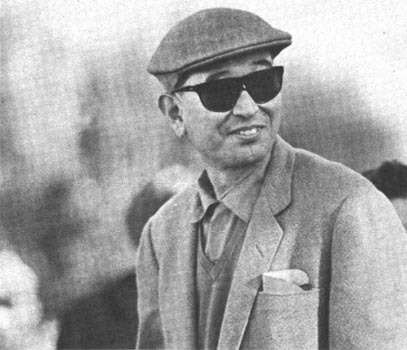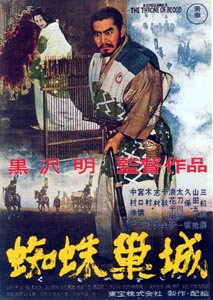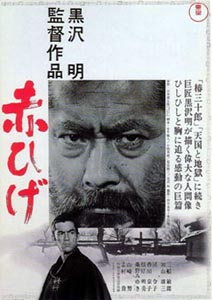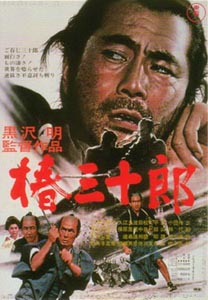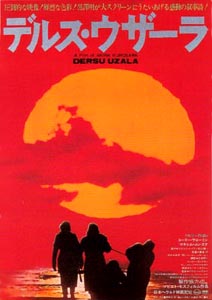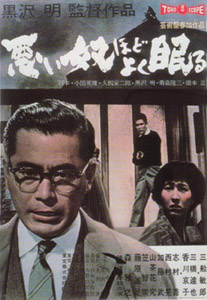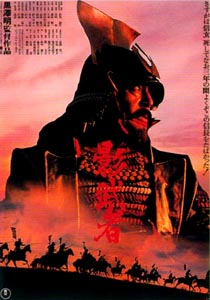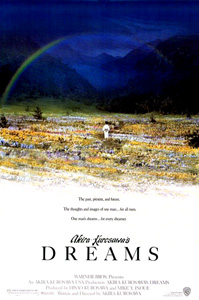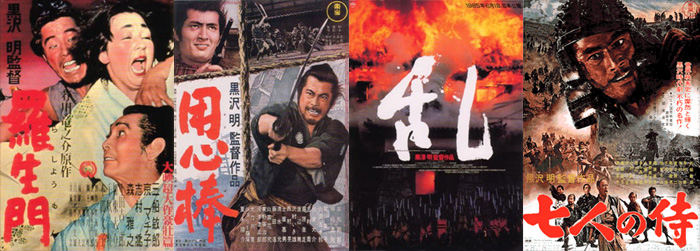 The American Cinematheque will screen 12 classic Akira Kurosawa films this month at the Aero Theatre. RASHOMON © 1950 Kadokawa Pictures, Inc. YOJIMBO, RAN, SEVEN SAMURAI © Toho Co., Ltd.
The American Cinematheque will screen 12 classic Akira Kurosawa films this month at the Aero Theatre. RASHOMON © 1950 Kadokawa Pictures, Inc. YOJIMBO, RAN, SEVEN SAMURAI © Toho Co., Ltd.Source: American Cinematheque Beginning tomorrow and running thru the end of January, the American Cinematheque`s Aero Theatre will screen a dozen films by the legendary director Akira Kurosawa. The lineup includes such masterpieces as RASHOMON, YOJIMBO, RAN, THRONE OF BLOOD, and SEVEN SAMURAI. The Aero Theatre is located at 1328 Montana Avenue at 14th Street in Santa Monica, CA 90403. Ticket prices to the theater are $10.00 general, $8.00 students and seniors, and $7.00 for American Cinematheque members. Double features are two films for one ticket price. Tickets can be purchased at the theater box office and on fandango.com. Complete ordering instructions, parking info, and directions are available on the Aero Theatre website. _______________________________________________________________________________________________________ In A Lonely Place - Akira Kurosawa Retrospective Series compiled by Gwen Deglise Program notes by Chris D. and William Boodell Special Thanks: Sarah Finklea/JANUS FILMS; WELLSPRING; Jessica Rosner/KINO INTERNATIONAL; Marilee Womack/WARNER BROS.
Born in 1910 to a family descended from samurais, Akira Kurosawa initially intended to be a painter, but found himself drifting away from it when he saw an ad in a newspaper for assistant director positions at Photo Chemical Laboratory (P.C.L.) film studios (presently to become Toho Studios). Kurosawa applied and was accepted, soon finding himself under the mentorship of director Kajiro Yamamoto, under whose guidance he flourished. He began by writing highly original screenplays such as WRESTLING RING FESTIVAL and THE STORY OF A BAD HORSE. After various attempts at directing his own feature, it finally came to pass in Yokohama in 1942 with SANSHIRO SUGATA. "After the tests were done and we were ready to shoot, with the cameras rolling I gave the call for action, `Yoi, staato!` (`Ready, start!`) The whole crew turned to stare at me. Apparently my voice sounded a little peculiar. I had done plenty of second-unit directing for Yama-san, but, no matter how much experience you have, when you finally reach the point of directing your own first film you are in a state of extreme tension. But from the second shot my tension disappeared; everything just felt exciting, and all I wanted to do was hurry on." – Akira Kurosawa, Something Like an Autobiography And hurry on he did with such initial films as THE MOST BEAUTIFUL, SANSHIRO SUGATA PART II, THE MEN WHO TREAD ON THE TIGER’S TAIL, NO REGRETS FOR OUR YOUTH, ONE WONDERFUL SUNDAY and DRUNKEN ANGEL (the latter being the first of his fruitful collaborations with powerhouse actor Toshiro Mifune and dynamic composer Hayasaka Fumio), and his superb STRAY DOG. Since bursting upon the international film scene in 1950 with his eleventh century period film, RASHOMON, Winner of the Grand Prix at the Venice International Film Festival and Best Foreign Language Film Oscar, Kurosawa was placed firmly into the top ranks of world filmmakers. His films accomplish what only the masters manage to do, a seamless marriage of compelling entertainment with challenging, brilliant and unique aesthetic expression. The influence of the culture of the West on his films is considerable, and in turn Kurosawa`s influence on the films of the West and, indeed, world cinema is vast and incalculable. When he died in 1998, cinema lost one of its greatest masters. Including STRAY DOG and RASHOMON, twelve of Kurosawa`s most popular and fascinating works are presented here for your enjoyment and marvel: his highly influential THE SEVEN SAMURAI; his reworking of Shakespeare`s "Macbeth" entitled THRONE OF BLOOD; his dark crime tale, THE BAD SLEEP WELL; his action-packed chanbara YOJIMBO and its follow-up, SANJURO; his tale of compassion and hope amidst illness and death, RED BEARD; DERSU UZALA, a Russian story filmed for two years in the barren wastess of Siberia; and two phenomenal, boldly moving and epic samurai tragedies, KAGEMUSHA and his "King Lear" adaptation, RAN.
Thursday, January 18– 7:30 PM STRAY DOG (Nora Inu), 1949, Janus Films, 122 min. One sweltering summer day, young police detective Toshiro Mifune has his gun lifted from him on a bus. Impatient Mifune’s frenzied efforts to find the homicidal fugitive responsible, both to atone to his superiors and to his calm, middle-aged partner (Takashi Shimura), and to prove his worth as a cop, leave the viewer breathless. Director Akira Kurosawa loved hardboiled American crime fiction, and there is no more conspicuous proof in his early career than in STRAY DOG. An expertly-paced, atmospheric suspense film that more than holds its own against the numerous noirs that were being produced across the Pacific in the United States. With Keiko Awaji, Isao Kimura. Friday, January 19– 7:30 PM Double Feature: RASHOMON, 1950, Janus Films, 88 min. The film which introduced not only classic Japanese cinema but an exceptional new talent, director Akira Kurosawa to a widespread international audience. Based on the short story In a Grove by Ryunosuke Akutagawa, a tragic event involving a husband (Masayuki Mori), his wife (Machiko Kyo) and a local bandit (Toshiro Mifune) is recounted by participants and witnesses yielding conlicting accounts. Kurosawa explores the nature of truth, human fallibility and hope in a story that examines each version of what happened one hot, fateful day in a thick and lonely forest. With exceptional cinematography from the great Kazuo Miyagawa and a phenomenally ecclectic score from Fumio Hayasaka; and that`s just a start. From the wonderfully theatrical acting to the smooth-like-butter cuts-on-action to the astonishingly visceral orchestration of sound and images, RASHOMON clearly demonstrates Kurosawa`s brilliance.
THRONE OF BLOOD (Kumonosu Jo), 1957, Janus Films, 105 min. As its alternate English titles (COBWEB CASTLE and CASTLE OF THE SPIDER’S WEB) suggest, director Akira Kurosawa’s adaptation of Shakespeare’s "Macbeth" is a chilling blend of gothic melodrama and samurai swordplay, Elizabethan tragedy and Noh Theater. Taketori Washizu (Toshiro Mifune), inspired by a ghostly vision and coaxed by his frighteningly ambitious spouse, Lady Asaji (Isuzu Yamada), conspires to murder his lord to rise in the ranks to become eventual ruler. In the process, he betrays friends and foes alike, is driven to madness along with his cold-hearted spouse and overwhelmed by the violent forces of chaos. With Takashi Shimura, Minoru Chiaki, Akira Kubo. "Kurosawa’s Throne of Blood is the grizzliest Macbeth you’re likely ever to see. It’s powerful filmmaking and provides much revelatory cultural frisson. It also features some of the best work of Kurosawa’s alter-ego Toshiro Mifune." – Marjorie Baumgarten, Austin Chronicle Saturday, January 20– 7:30 PM RAN, 1985, Wellspring, 160 min. Arguably Akira Kurosawa`s last masterpiece in a career of masterpieces, this sensually epic and colorfully dream-like samurai/Noh Theater rendition of Shakespeare`s "King Lear" bleeds right off the screen. A once-merciless and bloodthirsty Lord Hidetora (Tatsuya Nakadai), now old, war-weary and bathing in the spoils of a lifetime of plunder, leaves his kingdom to his three sons, Taro (Akira Terao), Jiro (Jinpachi Nezu) and Saburo (Daisuke Ryu). Trouble arises when youngest Saburo challenges his father`s actions, and he is banished from the kingdom, which is then left completely to his two brothers. As Hidetora attempts to enjoy his retirement in the twilight years, the once high king is dropped into a nightmarish hell when inter-filial squabbling erupts. Kurosawa was seventy-nine years old when RAN was released, and it shows in the easy lyricality and sure-handedness of one who has spent a lifetime making films. Yet it also has an inventiveness and energy which most directors couldn`t achieve at any age. It perceptively focuses on the dark sides of power: jealousy, deceit and betrayal, as well as Japanese ideas of obligation and honor, and, finally, hope and redemption. But the deeply-flawed Lord Hidetora will not leave this world unscathed, as his life will be wickedly spun and shaken. It is not for naught that Kurosawa named this twilight masterpiece RAN (which translates as "Chaos") You do not want to miss this one on the big screen.
Sunday January 21– 7:30 PM RED BEARD (Akahige), 1965, Janus Films, 185 min. A period film set in samurai times without a sword-wielding hero in sight, this remains one of Akira Kurosawa’s most humanistic efforts. The subject is a run-down infirmary for the poor in feudal Japan where a confident, young novice physician, Dr. Noboru (Yuzo Kayama) is sent to begin his career. Expecting to visit only temporarily and then to leave to serve the Shogunate, he is infuriated to learn he must remain at the destitute hospital, which is brimming with society`s dying poor, wretched and unwanted. Though he learns that the patients need him, Noboru is quick to take measures that will ensure his termination. But he is foiled at every turn by head man, Dr. Kyojio, otherwise known as "Akahige" or "Red Beard" (Toshiro Mifune) whose methods and behavior are as caring and compassionate as they are unconventional and unpredictable. At times RED BEARD veers dagerously close to soap-box philosophizing and pretension. But ultimately the film earns the emotions and ideas it attempts to evoke; the young doctor`s heart and mind are forever changed, and we are as enamored of Red Beard and his patients as Noboru. And like the young Noboru and his colleagues, we hope that when, one day, faced with such dire misfortune and misery, we too may be like him.
Wednesday, January 24– 7:30 PM Double Feature: YOJIMBO, 1961, Janus Films, 110 min One of Akira Kurosawa’s ‘lighter’ (and best) efforts finds sardonic gallows humor permeating a near-perfect adventure film with recognizably human characters. Toshiro Mifune plays Sanjuro, a shiftless ronin who wanders into a starving village beset by a yakuza gang war between two rival clans. To make money as well as amuse himself, he plays them off against each other and nearly gets killed in the process. Tatsuya Nakadai does a memorable turn in a comparatively small role as the pistol-packing dandy brother of one of the bosses. Sergio Leone did an unauthorized remake, the almost-as-good spaghetti western, A FISTFUL OF DOLLARS. But Kurosawa, himself, got the idea from Dashiell Hammet’s tough-as-nails 1930’s crime saga, Red Harvest, about a nameless, hard-drinking operative in the midst of a gang war in a small midwestern town. SANJURO (Tsubaki Sanjuro), 1962, Janus Films, 96 min. Director Akira Kurosawa helms this YOJIMBO sequel, utilizing Shugoro Yamamoto’s novel, Peaceful Days as a model. Wandering ronin, Sanjuro (Toshiro Mifune) decides to help a young samurai (Yuzo Kayama) and his brash cohorts when Kayama’s uncle (Yunosuke Ito), the chamberlain of their clan, is framed by a corrupt supertintendent. Much of the humor and character interplay is based on Mifune’s scruffy appearance and the seeming contradiction – at least to the proper adolescent swordsmen – of his consummate, strategic skill. Tatsuya Nakadai is the prime adversary, a proud samurai in the superintentdent’s employ every bit as dangerous as Mifune. There’s not nearly as much swordplay here as in YOJIMBO – since the war is mainly one of words and subterfuge – but when the final burst of violence erupts courtesy of Mifune and Nakadai, it’s a dazzling shocker. Director Kihachi Okamoto went back to Yamamoto’s orignal source novel for his own great, but very different, action-packed version, KILL!.
Thursday, January 25 – 7:30 PM DERSU UZALA, 1975, Kino International, 141 min. Director Akira Kurosawa was pulling himself out of a suicidal depression when he agreed to helm this Soviet-Japanese co-production, a film that went on to win an Oscar for Best Foreign Language Film. When Captain Vladimir (Yuri Solomin) and his Siberian forest expedition meet a diminutive mountain man, Dersu Uzala (Maksim Munzuk) at their rural campsite, a friendship begins that will span decades. Kurosawa perceptively and subtly explores the inevitable clash of civilization and nature, focusing on a relationship between two men who are very different, yet share a warm, kindred spirit. Ultimately, ‘rational’ realty in the form of Vladimir collides with the holistic, all-is-one-with-nature being that is Dersu, leading to an unwished for, but tragic resolution. From Siberia’s wildly beautiful wooded landscapes to its pitiless, snow-ravaged wastes, a stirringly timeless evocation of man’s fateful, often fractured and awkward place in the world.
Friday, January 26– 7:30 PM THE BAD SLEEP WELL (Warui Yatsu Hodo Yoku Nemuru), 1960, Janus Films, 151 min. Director Akira Kurosawa’s uncompromising expose of Japanese white collar crime is a startingly bleak saga of Toshiro Mifune infiltrating the family of a corrupt, big businessman (Masayuki Mori) who had his father, one of his underlings, murdered. Mifune, having switched identities with a friend (Takeshi Kato), worms his way into Mori’s household by marrying Mori’s crippled daughter (Kyoko Kagawa) and becoming best friends with his son (Tatsuya Mihashi) - both of whom are decent and don’t approve of their father’s nefarious connections with dishonest politicians and the underworld. Ironically, it is Mifune actually falling-in-love with Kagawa which lessens his resolve. Something which sociopath Mori ultimately manipulates to his advantage for the brutally realistic and pitiless conclusion.
Saturday, January 27– 7:30 PM KAGEMUSHA, 1980, 179 min, Co-produced by Francis Coppola and George Lucas during the latter part of Akira Kurosawa`s career when he often had trouble with financing, this winner of Cannes’ Palm de Or is a melancholy epic of disillusionment. When the double (and brother) Nobukado (Tsutomu Yamazaki) of Lord Shingen Takeda (Tatsuya Nakadai), comes across a condemned thief (also Nakadai) who looks uncannily like ruler Shingen, Nobukado proposes an idea to his brother’s court. In a bid to save himself from having to continue life as his brother`s "shadow," Nobukado trains the thief to be the lord`s double. When Shingen dies by an enemy sharp-shooter`s rifle, his military chiefs heed the final request of their lord, and inform the thief he must now double full-time to fool their rivals into believing Shingen is still alive. Yet, how long can the shadow exist without his subject? The film asks, "At some point, may the shadow become the main subject himself?" And, quite crucially, "If it does, will the others realize it?" Kurosawa`s haunting tale fantastically weaves tides of expressive color and smoke, evoking truth and lies, clarity and confusion, devotion and betrayal.
Sunday, January 28– 7:30 PM THE SEVEN SAMURAI (Shichinin no Samurai), 1954, Janus Films, 207 min. Director Akira Kurosawa’s most famous film is certainly one of the finest movies ever made - a huge, sprawling but intimate, character-driven period epic about an aging swordsman (the great Takashi Shimura) who enlists six other warriors-for-hire (amongst them, Toshiro Mifune, Minoru Chiaki, Isao Kimura, Daisuke Kato, Seiji Miyaguchi, Yoshio Inaba) to safeguard a remote village plagued by bandits. One of Kurosawa’s prime talents as director, aside from his meticulous attention to writing and character development, was his ability to create a lived-in wealth of detail in all of his in-period samurai films. Nowhere is this talent more evident than in this hypnotic evocation of a bygone age. The action film prototype, enormously influential on a legion of filmmakers from around the world, including Sam Peckinpah and Clint Eastwood. "Moves like hot mercury, and it draws a viewer so thoroughly into its world that real life can seem thick and dull when the lights come up." – Ty Burr, Boston Globe Wednesday, January 31– 7:30 PM DREAMS (Yume), 1990, Warner Bros., 119 min. One of maestro Akira Kurosawa’s last films is an anthology of eight dream episodes adapted from the director’s own nocturnal reveries. The mysteries of childhood, nature and man’s seemingly eternal predilection for self-destruction are the main themes, depicted sinply and with a sense of childlike wonder. Kurosawa drew on the fantasy cinema expertise of lifelong friend, director Ishiro Honda (GOJIRA) who was uncredited co-director on the two episodes "The Tunnel" and "Mount Fuji In Red" as well as the prologue and epilogue of "The Weeping Demon". Another master filmmaker, Martin Scorsese also participated, but as an actor, giving a very convincing portrayal of Vincent Van Gogh in "The Crows" segment. Another one of Kurosawa’s splendid visual achievements that really needs to be seen on the big screen.
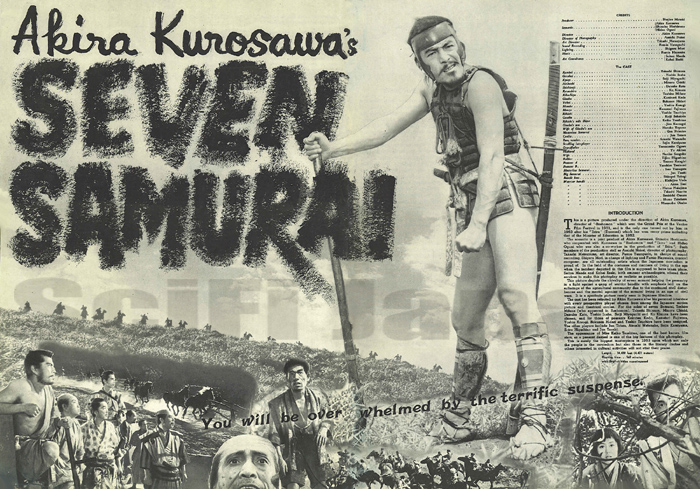 Rare Toho promotional material for SEVEN SAMURAI, created for international sales shortly after the film`s Japanese release. © 1954 Toho Co., Ltd.
Rare Toho promotional material for SEVEN SAMURAI, created for international sales shortly after the film`s Japanese release. © 1954 Toho Co., Ltd.

